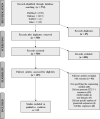An overview of sequencing technology platforms applied to HTLV-1 studies: a systematic review
- PMID: 34415436
- PMCID: PMC8377154
- DOI: 10.1007/s00705-021-05204-w
An overview of sequencing technology platforms applied to HTLV-1 studies: a systematic review
Abstract
Human T-lymphotropic virus type 1 (HTLV-1) was the first human retrovirus described. The viral factors involved in the different clinical manifestations of infected individuals are still unknown, and in this sense, sequencing technologies can support viral genome studies, contributing to a better understanding of infection outcome. Currently, several sequencing technologies are available with different approaches. To understand the methodological advances in the HTLV-1 field, it is necessary to organize a synthesis by a rigorous review. This systematic literature review describes different technologies used to generate HTLV-1 sequences. The review follows the PRISMA guidelines, and the search for articles was performed in PubMed, Lilacs, Embase, and SciELO databases. From the 574 articles found in search, 62 were selected. The articles showed that, even with the emergence of new sequencing technologies, the traditional Sanger method continues to be the most commonly used methodology for generating HTLV-1 genome sequences. There are many questions that remain unanswered in the field of HTLV-1 research, and this reflects on the small number of studies using next-generation sequencing technologies, which could help address these gaps. The data compiled and analyzed here can help research on HTLV-1, assisting in the choice of sequencing technologies.
© 2021. The Author(s), under exclusive licence to Springer-Verlag GmbH Austria, part of Springer Nature.
Conflict of interest statement
The authors declare no conflict of interest. The funder had no role in the design of the study; in the collection, analysis, or interpretation of data, in the writing of the manuscript, or in the decision to publish the results.
Figures




References
-
- de-Thé G, Gessain A, Gazzolo L, et al. Comparative seroepidemiology of HTLV-I and HTLV-III in the French West Indies and some African countries. Cancer Res. 1985;45:4633s–4636s. - PubMed
Publication types
MeSH terms
Grants and funding
LinkOut - more resources
Full Text Sources

